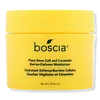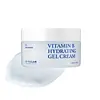What's inside
What's inside
 Key Ingredients
Key Ingredients

 Benefits
Benefits

 Concerns
Concerns

 Ingredients Side-by-side
Ingredients Side-by-side

Water
Skin ConditioningCaprylic/Capric Triglyceride
MaskingGlycerin
HumectantButyrospermum Parkii Butter
Skin ConditioningGlyceryl Stearate Citrate
EmollientLactobacillus Ferment
Skin ConditioningMangifera Indica Seed Butter
Skin ConditioningCeramide NP
Skin ConditioningCeramide AP
Skin ConditioningCeramide EOP
Skin ConditioningCitrus Aurantium Dulcis Callus Culture Extract
Skin ConditioningMarrubium Vulgare Extract
Skin ConditioningThioctic Acid
AntioxidantPhytosphingosine
Skin ConditioningCholesterol
EmollientCalcium Gluconate
HumectantSimmondsia Chinensis Seed Extract
AbrasiveEpilobium Angustifolium Flower/Leaf/Stem Extract
Skin ConditioningMoringa Oleifera Seed Oil
EmollientCurcuma Longa Root Extract
MaskingCucumis Sativus Fruit Extract
EmollientOcimum Basilicum Flower/Leaf Extract
TonicCucumis Melo Fruit Extract
Skin ConditioningPyrus Malus Fruit Extract
Skin ConditioningRose Extract
Skin ConditioningCorallina Officinalis Extract
Skin ConditioningOcimum Sanctum Leaf Extract
Skin ConditioningMelia Azadirachta Flower Extract
Skin ConditioningMelia Azadirachta Extract
Skin ConditioningMelia Azadirachta Leaf Extract
Skin ConditioningLonicera Caprifolium Flower Extract
PerfumingLonicera Japonica Flower Extract
Skin ConditioningLeuconostoc/Radish Root Ferment Filtrate
AntimicrobialCaprylyl Glycol
Emollient1,2-Hexanediol
Skin ConditioningCitric Acid
BufferingAcrylates/C10-30 Alkyl Acrylate Crosspolymer
Emulsion StabilisingXanthan Gum
EmulsifyingCarbomer
Emulsion StabilisingSodium Lactate
BufferingSodium Stearate
CleansingSodium Lauroyl Lactylate
EmulsifyingDecyl Glucoside
CleansingLauryl Glucoside
CleansingWater, Caprylic/Capric Triglyceride, Glycerin, Butyrospermum Parkii Butter, Glyceryl Stearate Citrate, Lactobacillus Ferment, Mangifera Indica Seed Butter, Ceramide NP, Ceramide AP, Ceramide EOP, Citrus Aurantium Dulcis Callus Culture Extract, Marrubium Vulgare Extract, Thioctic Acid, Phytosphingosine, Cholesterol, Calcium Gluconate, Simmondsia Chinensis Seed Extract, Epilobium Angustifolium Flower/Leaf/Stem Extract, Moringa Oleifera Seed Oil, Curcuma Longa Root Extract, Cucumis Sativus Fruit Extract, Ocimum Basilicum Flower/Leaf Extract, Cucumis Melo Fruit Extract, Pyrus Malus Fruit Extract, Rose Extract, Corallina Officinalis Extract, Ocimum Sanctum Leaf Extract, Melia Azadirachta Flower Extract, Melia Azadirachta Extract, Melia Azadirachta Leaf Extract, Lonicera Caprifolium Flower Extract, Lonicera Japonica Flower Extract, Leuconostoc/Radish Root Ferment Filtrate, Caprylyl Glycol, 1,2-Hexanediol, Citric Acid, Acrylates/C10-30 Alkyl Acrylate Crosspolymer, Xanthan Gum, Carbomer, Sodium Lactate, Sodium Stearate, Sodium Lauroyl Lactylate, Decyl Glucoside, Lauryl Glucoside
Water
Skin ConditioningPanthenol
Skin Conditioning1,2-Hexanediol
Skin ConditioningHydrogenated Poly(C6-14 Olefin)
EmollientAmmonium Acryloyldimethyltaurate/Vp Copolymer
Isostearyl Alcohol
EmollientMannitol
HumectantButylene Glycol Cocoate
EmulsifyingHydroxyacetophenone
AntioxidantMicrocrystalline Cellulose
AbsorbentSucrose
HumectantEthylhexylglycerin
Skin ConditioningZea Mays Starch
AbsorbentEthylcellulose
Hydroxypropyl Methylcellulose
Emulsion StabilisingCitric Acid
BufferingSodium Hyaluronate
HumectantCI 77007
Cosmetic ColorantGlycerin
HumectantButylene Glycol
HumectantHydrogenated Lecithin
EmulsifyingFicus Carica Fruit Extract
HumectantCentella Asiatica Extract
CleansingTocopherol
AntioxidantCeramide NP
Skin ConditioningHydrolyzed Hyaluronic Acid
HumectantSodium Acetylated Hyaluronate
HumectantCyanocobalamin
Skin ConditioningWater, Panthenol, 1,2-Hexanediol, Hydrogenated Poly(C6-14 Olefin), Ammonium Acryloyldimethyltaurate/Vp Copolymer, Isostearyl Alcohol, Mannitol, Butylene Glycol Cocoate, Hydroxyacetophenone, Microcrystalline Cellulose, Sucrose, Ethylhexylglycerin, Zea Mays Starch, Ethylcellulose, Hydroxypropyl Methylcellulose, Citric Acid, Sodium Hyaluronate, CI 77007, Glycerin, Butylene Glycol, Hydrogenated Lecithin, Ficus Carica Fruit Extract, Centella Asiatica Extract, Tocopherol, Ceramide NP, Hydrolyzed Hyaluronic Acid, Sodium Acetylated Hyaluronate, Cyanocobalamin
 Reviews
Reviews

Ingredients Explained
These ingredients are found in both products.
Ingredients higher up in an ingredient list are typically present in a larger amount.
1,2-Hexanediol is a synthetic liquid and another multi-functional powerhouse.
It is a:
- Humectant, drawing moisture into the skin
- Emollient, helping to soften skin
- Solvent, dispersing and stabilizing formulas
- Preservative booster, enhancing the antimicrobial activity of other preservatives
Ceramide NP is a type of ceramide and formally known as ceramide 3.
Ceramides are intercellular lipids naturally found in our skin that bonds dead skin cells together to create a barrier. They are known for their ability to hold water and thus are a great ingredient for dry skin.
Ceramides are an important building block for our skin barrier. A stronger barrier helps the skin look more firm and hydrated. By bolstering the skin ceramides act as a barrier against irritating ingredients. This can help with inflammation as well.
If you would like to eat ceramides, sweet potatoes contain a small amount.
Read more about other common types of ceramides here:
Ceramide AP
Ceramide EOP
Citric Acid is an alpha hydroxy acid (AHA) naturally found in citrus fruits like oranges, lemons, and limes.
Like other AHAs, citric acid can exfoliate skin by breaking down the bonds that hold dead skin cells together. This helps reveal smoother and brighter skin underneath.
However, this exfoliating effect only happens at high concentrations (20%) which can be hard to find in cosmetic products.
Due to this, citric acid is usually included in small amounts as a pH adjuster. This helps keep products slightly more acidic and compatible with skin's natural pH.
In skincare formulas, citric acid can:
While it can provide some skin benefits, research shows lactic acid and glycolic acid are generally more effective and less irritating exfoliants.
Most citric acid used in skincare today is made by fermenting sugars (usually from molasses). This synthetic version is identical to the natural citrus form but easier to stabilize and use in formulations.
Read more about some other popular AHA's here:
Learn more about Citric AcidGlycerin is already naturally found in your skin. It helps moisturize and protect your skin.
A study from 2016 found glycerin to be more effective as a humectant than AHAs and hyaluronic acid.
As a humectant, it helps the skin stay hydrated by pulling moisture to your skin. The low molecular weight of glycerin allows it to pull moisture into the deeper layers of your skin.
Hydrated skin improves your skin barrier; Your skin barrier helps protect against irritants and bacteria.
Glycerin has also been found to have antimicrobial and antiviral properties. Due to these properties, glycerin is often used in wound and burn treatments.
In cosmetics, glycerin is usually derived from plants such as soybean or palm. However, it can also be sourced from animals, such as tallow or animal fat.
This ingredient is organic, colorless, odorless, and non-toxic.
Glycerin is the name for this ingredient in American English. British English uses Glycerol/Glycerine.
Learn more about GlycerinWater. It's the most common cosmetic ingredient of all. You'll usually see it at the top of ingredient lists, meaning that it makes up the largest part of the product.
So why is it so popular? Water most often acts as a solvent - this means that it helps dissolve other ingredients into the formulation.
You'll also recognize water as that liquid we all need to stay alive. If you see this, drink a glass of water. Stay hydrated!
Learn more about Water